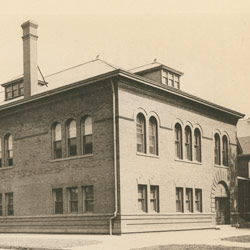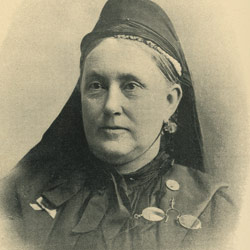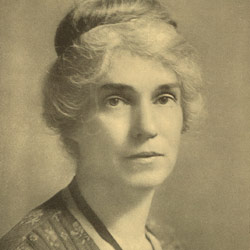The Women of Peoria Women’s Club

Located at the corner of Madison and Fayette, the Peoria Women’s Club was established in 1886 by some amazing local women who were doing important work in the community.
Like other similar organizations founded in the late 19th century, the Peoria Women's Club offered women a forum for their public opinions, "much to the consternation of the men," as the Peoria Star put it at the time. The Club focused most of its early efforts on the arts, but over the years, it began to take a broader role in civic affairs. Here are the stories of several women who were critical to the early growth of the Peoria Women’s Club.
Clara Parsons Bourland
Clara Parsons Bourland was born in 1838 in West Granville, Massachusetts. She attended eastern schools before moving to Chicago, where she worked as a teacher for several years before meeting and marrying widower Benjamin L.T. Bourland, a businessman from Peoria who was involved in real estate. Clara helped to raise the two sons her husband had from a previous marriage, in addition to the two girls and four boys the couple would have over the next 17 years.
When her youngest child was six years old, Clara packed the family up and traveled to Europe, settling in Paris, France, which, in the 1880s, was the cultural capital of the world. During the Bourlands’ time in Paris, their days and nights were filled with music and the arts. After a few years, they returned to Peoria, and Clara was determined to bring the arts and culture that was so prevalent in Europe back home to central Illinois.
Upon sharing her experiences with her lady friends, the idea came about to form a group that would educate women in the arts. And so, the Peoria Women’s Club was formed, with 24 women as co-founders. Clara was the club’s first president, a position she maintained for 25 years. At first, the women met at various homes in the area, but the organization sought a more permanent home where they could invite speakers to enlighten their membership. To that end, the ladies formed a stock company, selling shares for $10 a piece until they had raised a total of $25,000.
A lot in downtown Peoria at the corner of Fayette and Madison streets was purchased, and soon, the group had hired contractors to build a clubhouse and music hall. In 1893, the cornerstone was laid in the two-story building, which, once complete, would offer a full stage and rack seating on the second floor. The Peoria Players, Peoria Symphony Orchestra and many nationally known entertainers performed there, including Carl Sandburg and Victor Hugo. Each year on Shakespeare’s birthday, the ladies would stage one of the Bard’s great works of drama.
By the early 1900s, the Peoria Women’s Club had grown to 360 members, and the group began to work together more closely to address important community issues. The Club played a key role in the development of the Bartonville State Hospital for the Insane, after seeing the need for a place to house the mentally ill and lobbying Springfield to facilitate such a place. After that success, they lobbied for a law to educate and care for blind children and helped start the first public kindergarten, as well as a traveling library.
Anna S. Adams
Although little is known of her personal life, it is known that Dr. Anna S. Adams always dreamed of becoming a doctor. Born in Bristol, Pennsylvania in the 1840s, she lived at a time when there were not many medical schools, and those that did exist did not admit women. In 1849, the first medical school awarded a woman a degree in medicine, which paved the way for women like Anna to become licensed medical doctors as well. She moved from Bristol to Philadelphia to study under a Dr. Warrington before attending the Female Medical College and practicing at the Women’s Hospital of Philadelphia.
Upon graduation, Anna worked at the Electropathic Institute of Ohio before relocating to Peoria in 1875. There, she became the first woman with a medical degree to open her own practice, which was located at 201 S. Adams Street. The Peoria Medical Society invited Dr. Adams to become a member—something that was quite rare at the time—and in 1875, she joined the Society’s Board of Censors, which reviewed the qualifications of membership applicants, where she served first as secretary, and then as treasurer. A charter member of the Peoria Women’s Club, Adams’ disappearance from public records after 1886 leaves her legacy somewhat of a mystery.
 Lucie Brotherson Tyng
Lucie Brotherson Tyng
Lucie Brotherson Tyng was born in 1835 in Elmira, New York, and moved to Ohio before settling in Peoria in 1851. At the young age of 16, she married Alexander Griswold Tyng, who was a respected grain merchant in Peoria for many years. Over the next two decades, she gave birth to 10 children, six of whom died early in life.
Lucie was very active in the community, paying particular attention to the local school system. She was the first woman to be elected to the school board, then known as the Board of School Inspectors, and served as its treasurer until she died of heart failure in 1905. In 1914, the board decided to build another grade school and chose to name it after a “woman of distinction.” The Lucie B. Tyng School opened on January 15, 1915.
Lucie was active in the Woman’s Christian Temperance Union—this was during the time that Peoria was known as the “Whiskey Capital of the World”—and she later became president of the organization. She was also involved with the Ladies Memorial Society, the group which helped raise the money to erect a monument honoring the nation’s soldiers. It was responsible for bringing President McKinley to Peoria in 1899 for the dedication of the “Soldiers and Sailor Monument,” which still stands at the Peoria County Courthouse.  Julia Proctor White
Julia Proctor White
Julia Proctor was born in Peoria in 1875 and married Charles White in 1901. A kindergarten teacher, she was the first vice president of the Peoria Free Kindergarten Association, whose efforts ensured that public school kindergartens were established in Peoria in 1907.
Julia and her friend, Mary H. Whitten, were troubled by the problem of children on the streets during school hours, and so they asked other women’s clubs to join them in petitioning the school board to hire a truancy officer. In 1905, she became the first president of t he Peoria Women’s Civic Federation, which was formed when 20 different clubs agreed to unite to work on projects that none could accomplish on their own.
Julia was one of the founders of the Peoria Women’s Club, and later became its second president. One of her major accomplishments within the club was the establishment of an evening department for business women. Ten years later, she became the first president of Peoria’s League of Women Voters. She was always involved in the arts and helped to originate the idea for a civic arts center in Peoria, which later became Lakeview Museum. During the 1950s, she wrote poetry, plays and numerous books, before passing away in 1968 at the age of 92.
Peoria Women’s Club
For over 125 years, the Peoria Women’s Club has been educating women in the fine arts, literature, public affairs, travel and more. Its members continue to be active in a variety of community initiatives, and the Club welcomes any woman interested in the arts and good fellowship to become a member.
In addition, if you’re looking for a unique, historical location to host an event, the Peoria Women’s Club building is available to rent for parties, rehearsal dinners, showers, weddings and other meetings. Visit peoriawomensclubofillinois.org for more information. iBi
» Much of the information in this article came from Women of Peoria: 1620 to 1920, written and researched by Peoria author and historian Channy Lyons. This book is an excellent resource for information on prominent local women during that time period.

